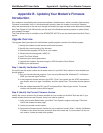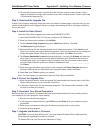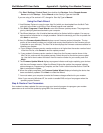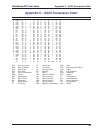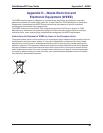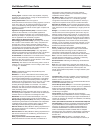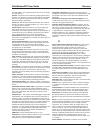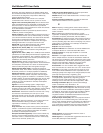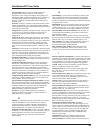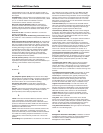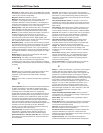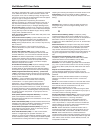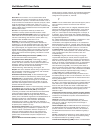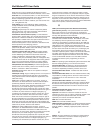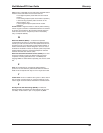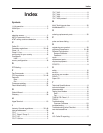
Glossary
39
MultiModemZPX User Guide
Fax (facsimile): Refers to the bit-mapped rendition of a
graphics-oriented document (fax) or to the electronic
transmission of the image over telephone lines (faxing). Fax
transmission differs from data transmission in that the former is
a bit-mapped approximation of a graphical document and,
therefore, cannot be accurately interpreted according to any
character code.
Firmware: A category of memory chips that hold their content
without electrical power, they include ROM, PROM, EPROM
and EEPROM technologies. Firmware becomes “hard software”
when holding program code.
Foreground: The application program currently running on and
in control of the PC screen and keyboard. The area of the
screen that occupies the active window. Compare with
“background”.
Fractional T1 (FT1): A digital data transmission rate between
56 Kbps (DS0 rate) and 1.544M bps (the full T1 rate - in North
America). FT1 is typically provided on 4-wire (two copper pairs)
UTP. Often used for video conferencing, imaging and LAN
interconnection due to its low cost and relatively high speed.
FT1 rates are offered in 64 Kbps multiples, usually up to 768
Kbps.
Frequency: A characteristic of an electrical or electronic signal
which describes the periodic recurrence of cycles. Frequency is
inversely proportional to the wavelength or pulse width of the
signal (i.e., long wavelength signals have low frequencies and
short wavelength signals yield high frequencies).
Foreign Exchange (FX): A CO trunk with access to a distant
CO, allowing ease of access and flat-rate calls anywhere in the
foreign exchange area.
Foreign Exchange Office (FXO): Provides local telephone
service from a CO outside of (“foreign” to) the subscriber’s
exchange area. In simple form, a user can pick up the phone in
one city and receive a tone in the foreign city. Connecting a
POTS telephone to a computer telephony system via a T1 link
requires a channel bank configured for the FX connection. To
generate a call from the POTS set to the computer telephony
system, a FXO connection must be configured.
Foreign Exchange Station (FXS): See FX, FXO. To generate a
call from the computer telephony system to the POTS set, an
FXS connection must be configured.
Forward Explicit Congestion Notification (FECN): A bit that
tells you that a certain frame on a particular logical connection
has encountered heavy traffic. The bit provides notification that
congestion-avoidance procedures should be initiatedin the
same direction of the received frame. See also BECN
(Backward Explicit Congestion Notification).
Function: A Universal Serial Bus device that provides a
capability to the host. For example, an ISDN connection, a
digital microphone, or speakers.
G
Gateway: 1. A functional unit that interconnects two computer
networks with different network architectures. A gateway
connects networks or systems of different architectures. A
bridge interconnects networks or systems with the same or
similar architectures. 2. A network that connects hosts.
Graphical User Interface (GUI): A type of computer interface
consisting of a visual metaphor of a real-world scene, often of a
desktop. Within that scene are icons, representing actual
objects, that the user can access and manipulate with a
pointing device.
H
Handshaking: A process that two modems go through at the
time of call setup to establish synchronization over the data
communications link. It is a synchronization and negotiation
process accomplished by the exchange of predefined, mutually
recognized control codes.
Hexadecimal: A base 16 numbering system used to represent
binary values. Hex uses the numbers 0-9 and the letters A-F:
usually notated by an “h” (e.g., “4CF h”, read “four charley fox,
hex”). The result is that one hex digit represents a 4-bit value.
High-level Data Link Control (HDLC): An ISO standard, bit-
oriented data communications protocol that provides nearly
error-free data transfers.
Host: The host computer system where the Universal Serial
Bus host controller is installed. This includes the host hardware
platform (CPU, bus, etc.) and the operating system in use.
Host Controller: The host’s Universal Serial Bus interface. A
hardware device that provides the interface to the Host
Controller Driver (HCD) and the USB bus.
Host Controller Driver (HCD): Software that provides an
interface to the USB Driver and the Host Controller. (The
interface to the Host Controller is defined by the OHCI spec.
I
Implicit congestion management: A method of informing the
terminal that the network is busy. This method relies on the end-
system protocol to detect and fix the congestion problem. (TCP/
IP is an example of a protocol using only implicit congestion
management.) See also “explicit congestion management”.
In-band: Refers to the type of signalling over the conversion
path on an ISDN call. Contrast “out-of-band”.
Insufficient Ones: A T1 error condition that is logged when
fewer than one 1 in 16 0s or less than 12.5 % average 1s
density is received.
Inter Exchange Carrier (IEC): The long distance company (LE)
who’s central office provides the point of reference for T1
access. Any common carrier authorized by the FCC to carry
customer transmissions between LATAs.
Internet: Refers to the computer network of many millions of
university, government and private users around the world.
Each user has a unique Internet Address.
Internet Address (IP Address): A unique 32-bit address for a
specific TCP/IP host on a network. Normally printed in dotted
decimal format (e.g., 129.128.44.227).
Internet Protocol (IP): A protocol used to route data from its
source to its destination in an Internet enviroment. The Internet
Protocol was designed to connect local area networks.
Although there are many protocols that do this, IP refers to the
global system of interconnecting computers. It is a highly
distributed protocol (each machine only worries about sending
data to the next step in the route).
Internetwork Packet Exchange (IPX): A NetWare
communications protocol used to route messages from one
node to another. IPX packets include network addresses and
can be routed from one network to another. An IPX packet can
occasionally get lost when crossing networks, thus IPX does
not guarantee delivery of a complete message. Either the
application has to provide that control, or NetWare’s SPX
protocol must be used.
Interoperable: Devices from different vendors that can
exchange information using a standard’s base protocol.
Interrupt Request: A hardware signal that allows a device to



